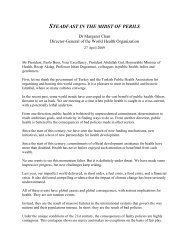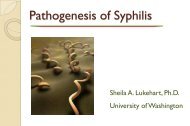The Evolution of HTA in Emerging Markets Health-Care ... - TREE
The Evolution of HTA in Emerging Markets Health-Care ... - TREE
The Evolution of HTA in Emerging Markets Health-Care ... - TREE
Create successful ePaper yourself
Turn your PDF publications into a flip-book with our unique Google optimized e-Paper software.
OHE Consult<strong>in</strong>g Report for PhRMA<br />
5 January 2011<br />
competitive pressure. Economic liberalisation also weakened the tax base and hence the ability <strong>of</strong><br />
governments to directly subsidise hospital and other health care facilities. Such government support<br />
as did rema<strong>in</strong> was directed at better <strong>of</strong>f workers (on the demand side), i.e. those work<strong>in</strong>g for the<br />
government or the more secure SOEs, and (on the supply side) at urban hospitals. <strong>The</strong>re was further<br />
geographical <strong>in</strong>equity as the poorer prov<strong>in</strong>ces lagged beh<strong>in</strong>d <strong>in</strong> <strong>in</strong>come growth and <strong>in</strong>terregional<br />
transfers via the central government lagged beh<strong>in</strong>d the growth <strong>of</strong> the economy<br />
Hospitals/health facilities were given “f<strong>in</strong>ancial autonomy” which meant they supplied “basic<br />
services at a loss (these were price controlled) and made pr<strong>of</strong>its on drugs and “high tech” care<br />
through a policy <strong>of</strong> charg<strong>in</strong>g for these non-‐basic services. Barefoot doctors who used to provide first-level<br />
[primary] care to the agricultural commune and workplace cl<strong>in</strong>ics, set up private village cl<strong>in</strong>ics<br />
as there was no longer communal fund<strong>in</strong>g to support them. Even utilisation <strong>of</strong> more basic health<br />
care services started to fall as health centres began charg<strong>in</strong>g even for public health services such as<br />
EPI and TB (outside <strong>of</strong> DOTS).<br />
Thus economic liberalisation reduced people’s access to healthcare (measured <strong>in</strong> terms <strong>of</strong> utilisation<br />
rates) and <strong>in</strong>creased the risk <strong>of</strong> them <strong>in</strong>curr<strong>in</strong>g large out-‐<strong>of</strong>-‐pocket expenditures when they did<br />
obta<strong>in</strong> access. Analysis seems to suggest that the ma<strong>in</strong> problems that emerged were:<br />
<br />
<br />
high out-‐<strong>of</strong>-‐pocket payments;<br />
high costs <strong>of</strong> health care, with <strong>in</strong>efficiencies due to long hospital stays, overuse <strong>of</strong> drugs, and<br />
overuse <strong>of</strong> <strong>in</strong>terventions such as caesarean sections and MRIs scans, as providers sought to<br />
compensate for reductions <strong>in</strong> government and <strong>in</strong>surance scheme payments (and artificially<br />
low prices for those services that were paid for) by charg<strong>in</strong>g for additional services.<br />
Consequences <strong>of</strong> the erosion <strong>of</strong> coverage and <strong>of</strong> public fund<strong>in</strong>g were that:<br />
<br />
<br />
<br />
Whilst Ch<strong>in</strong>a’s economic growth was high, its mortality rates were not fail<strong>in</strong>g <strong>in</strong> a way that<br />
reflected this. Ch<strong>in</strong>a now has heart disease, chronic lung disease, stroke, diabetes, cancer,<br />
and hypertension as a result <strong>of</strong> <strong>in</strong>creased <strong>in</strong>take <strong>of</strong> fat, sugar, and calories, more smok<strong>in</strong>g,<br />
accompanied by less exercise.<br />
health expenditures have placed a grow<strong>in</strong>g burden on poorer families, with evidence from<br />
2003 <strong>in</strong>dicat<strong>in</strong>g that out <strong>of</strong> pocket spend<strong>in</strong>g on health pushed an additional 19% <strong>of</strong> families<br />
below the $1.08 poverty l<strong>in</strong>e, with 76% and 79% respectively <strong>of</strong> the lowest <strong>in</strong>come urban<br />
and rural populations be<strong>in</strong>g without any <strong>in</strong>surance cover, result<strong>in</strong>g <strong>in</strong> them spend<strong>in</strong>g 10%<br />
and 21% <strong>of</strong> their <strong>in</strong>come respectively on medical expenditures (Ch<strong>in</strong>a MOH, 2003)<br />
public health <strong>in</strong> terms <strong>of</strong> primary care prevention, for which Ch<strong>in</strong>a had a high reputation,<br />
began to be neglected <strong>in</strong> the 1980s and 90s, and public health surveillance decl<strong>in</strong>ed likewise,<br />
hence HIV/AIDS, SARS and Avian Flu were not dealt with well and Ch<strong>in</strong>a has struggled to<br />
tackle TB and viral hepatitis.<br />
85








